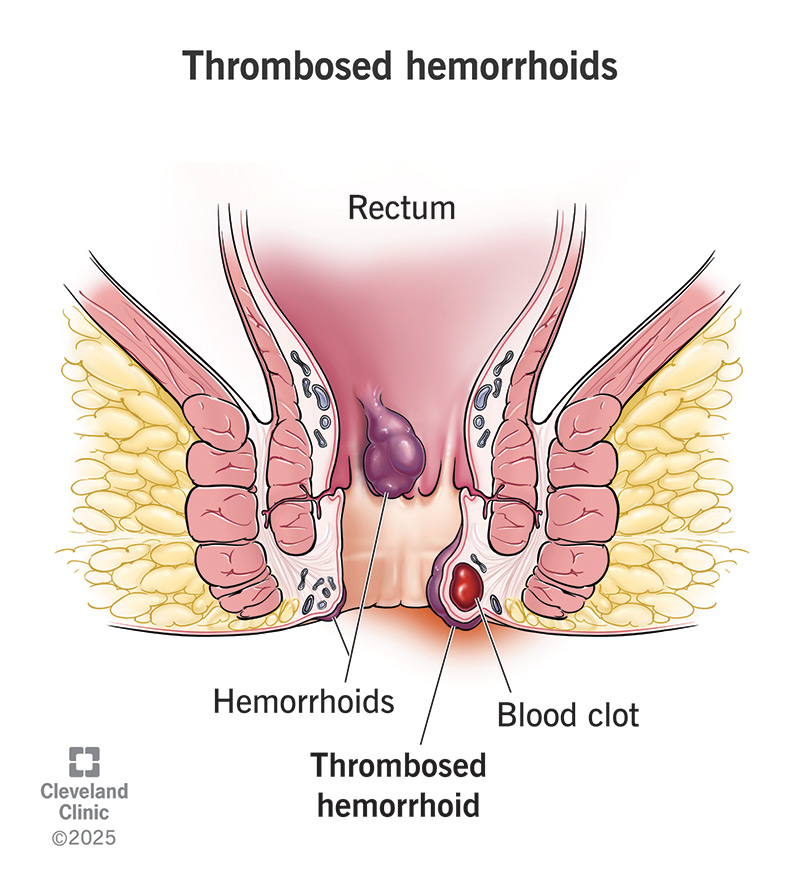Thrombosed hemorrhoids are when a blood clot forms inside a hemorrhoid. It can cause pain and itching. You’ll often see a blueish purple lump around your butthole. At-home treatment with sitz bath and over-the-counter creams and ointments can help treat thrombosed hemorrhoids. In severe cases, medical treatment is necessary.
Advertisement
Cleveland Clinic is a non-profit academic medical center. Advertising on our site helps support our mission. We do not endorse non-Cleveland Clinic products or services. Policy

A thrombosed hemorrhoid is when a blood clot forms inside a hemorrhoid. A hemorrhoid is a swollen vein in your rectum or anus. Sometimes, the swelling makes blood inside of the vein clot. This causes symptoms like pain, itching and rectal bleeding. Thrombosed hemorrhoids appear as a purple-blue lump, usually around your anus (butthole).
Advertisement
Cleveland Clinic is a non-profit academic medical center. Advertising on our site helps support our mission. We do not endorse non-Cleveland Clinic products or services. Policy
Thrombosed hemorrhoids can be external or internal:
Most thrombosed hemorrhoids get better with at-home treatments. If these don’t help, your healthcare provider may need to remove the clot in the office.
The biggest sign is a blueish-purple lump on or around your butthole. You can often see it or feel it. It can be extremely painful and tender.
Other symptoms include:
They occur when a blood clot develops inside a hemorrhoid. Hemorrhoids occur due to increased pressure in your rectum. This can happen when you perform activities that involve straining. (The clot is just in your anus and doesn’t travel to other parts of your body.)
Hemorrhoids are also more common as you age because the tissues and veins in your rectum weaken. This makes them even more likely to swell under pressure.
Advertisement
Any hemorrhoid has the possibility of becoming thrombosed. Activities or conditions that put you at risk for hemorrhoids are:
Thrombosed hemorrhoids aren’t life-threatening, but they can be very painful. Other than severe pain, other possible complications include:
You should contact your healthcare provider if you notice signs of infection, like a fever or chills.
A healthcare provider diagnoses thrombosed hemorrhoids based on your symptoms and a rectal exam. Often, you’ll have intense and sudden pain and a visible lump at your anus. This is usually all a provider needs to diagnose a thrombosed hemorrhoid. They may also ask you if you have frequent constipation.
Treatment often depends on the severity of the hemorrhoid. Most people feel the pain is most intense in the first 48 hours. You’ll usually find relief from at-home treatments like:
Often, at-home and over-the-counter treatments are enough to make a thrombosed hemorrhoid go away. Your body will eventually reabsorb the blood clot, and the pain will improve a little each day.
Draining the clot is an option if your pain is severe or you still feel a lot of pain after a few days of at-home treatment. Your healthcare provider may suggest a hemorrhoidectomy to remove the hemorrhoid.
Yes, most of them will go away within a few weeks.
You should never attempt to drain a hemorrhoid on your own. Only healthcare providers should remove or drain a thrombosed hemorrhoid.
No one wants to have hemorrhoids. They can be disruptive and uncomfortable. If a hemorrhoid causes intense pain and you notice a lump around your anus, it’s likely thrombosed. Most thrombosed hemorrhoids go away with at-home treatments like sitz baths and softening your stool. If you’re still in a lot of pain after a few days, contact a healthcare provider. They can take a look and recommend another way to treat a thrombosed hemorrhoid.
Advertisement
Any hemorrhoid can become thrombosed. So, the best prevention strategy is to reduce the risk of hemorrhoids altogether. Avoiding constipation is key.
Other tips are:
Contact your provider if you have a thrombosed hemorrhoid that causes you pain. While most get better in a few days on their own, you may need your healthcare provider’s help. A thrombosed hemorrhoid can become infected or rupture.
A thrombosed hemorrhoid can make everyday tasks like walking or sitting extremely painful. Fortunately, sitting in a sitz bath or using topical ointments can help you feel better. If they don’t, contact your healthcare provider to see what they recommend doing next. While it can be awkward to discuss your butthole, it may be necessary to find the relief you need.
Advertisement
When hemorrhoids cause pain or bleeding, you want the best possible care. Cleveland Clinic’s providers can make you more comfortable with a variety of treatments.

Last reviewed on 05/05/2025.
Learn more about the Health Library and our editorial process.